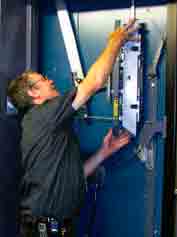Angelo Ippolito: Chiropractor to the NYC Elevator Set
Sep 1, 2017

Your author talks to a doctor who understands the unique needs of the elevator professional.
Have you ever felt that twinge in your spine? That stiffening in your neck? The pain that leaves you laid out on your back for days? You know what I’m talking about, and so does Dr. Angelo Ippolito, DC.
Elevator repair is especially dangerous for muscles, joints and ligaments. Most physical labor allows you to position your body in various ways to protect it. For example, while unloading a truck or working a jackhammer, you can keep your spine untorqued or bend your knees at appropriate times. In an elevator shaft, though, your range of motion is more constrained, and sometimes you are forced into positions that are not ideal. “For some of these guys,” says Ippolito, “they’ve got to retrofit themselves into a narrow space.” The biggest problems usually come from lifting heavy objects while bending forward or pushing overhead while your body is twisted.
Ippolito didn’t know any of this when he opened his first chiropractic office more than 20 years ago. He also didn’t have any particular interest in elevators; limousines were more his thing. After earning a pre-med degree at Yale University, he spent a few years driving a limo, one day picking up a bachelor party of chiropractors. By the end of the night, he had a new career in mind.
But, in 2001, when the landlord of his first office in Queens, New York City (NYC), doubled the rent, he found new accommodations nearby in Long Island City. He didn’t know the neighborhood, that it was a hub for the elevator industry, nor did he know the special health risks elevator repairmen face.
Within a month or two, he picked up his first elevator-industry patient, Brian, who worked at Mainco, just a few blocks from his office. Brian spread the word, and soon Ippolito was treating the aches and pains of a lot of elevator-industry professionals. He’s become one of the go-to back-and-joint men in the local industry.
If you go to see Ippolito, he’ll do a few things for you. He’ll teach you a little about your anatomy to give you a better understanding of what might be causing your pain. Sometimes, the source of the problem is not where the injury manifests. The pain is usually caused by a secondary injury, which, in turn, is caused by compensations your body has made to adapt to the primary injury.
He’ll also make some adjustments to your joints and spine, and manipulate the soft tissue with stretching, massage, myofascial release and instrument-assisted soft-tissue mobilization. And he’ll give you some brief exercises to do periodically throughout your workday.
If you’re an elevator-industry professional who has moved from the field to the back office, Ippolito still wants to see you. In fact, sitting at a desk all day is probably more dangerous to your spine than repairing an elevator. As he and others have said, “Sitting is the new smoking.” Sometimes, he tells his patients who work in offices that their backs would be in better shape if they worked as longshoremen. He says:
“The body is designed to move and to move heavy objects. Your spine wants that. There’s this misconception that the discs in the spine need to be preserved and babied, to not subject them to any kind of compression. That’s completely false. Going into a squatting position and lifting something, that’s good. When you’re sitting all day, you’re not getting any of that.”
He recommends that anyone with a desk job get up every 20 min. or so to engage in 60 s. of activity. Just walking around is good, but he has developed special exercises that he says are optimal.
Ippolito also warns against compensating for sitting all day by exercising more after work. He’s had many conversations with his patients, explaining to them that breaking up inactivity is just as important as bursts of exercise, and that most people who exercise this way are overtraining. Professional athletes, for example, are extremely fit, but that fitness often sacrifices long-term health with excessive wear on muscles and joints.
There’s also an insidious belief that elevators themselves are bad for you, because you’d burn more calories and less fossil fuel if you took the stairs. Several years ago, NBC ran public-service ads to this effect, starring Bethenny Frankel of The Real Housewives of New York, NBC journalist Natalie Morales and Jack McBrayer of 30 Rock. (The McBrayer ad was the most painful, because 30 Rock is among the most elevator-heavy and elevator-positive shows in the history of sitcoms.) The claim that elevators are bad for the environment is simply bogus. By increasing urban density, elevatored buildings decrease our use of fuel to drive cars and heat buildings. I suspected the “bad for you” claim was also wrong, so I ran it by Ippolito.
Yes, he agreed, walking up and (especially) down stairs can put unnecessary stress on your joints (not to mention the danger of falling down the stairs and hurting yourself). According to a report by the National Safety Council, in 2013, 2,233 Americans died “falling on and from stairs and steps,” about a hundred times more people than those killed in elevator accidents.
He is a little skeptical of the new movement in architectural design to put open staircases at the center of office buildings, encouraging people to walk the stairs more and even hold meetings on the stairs. And yes, he agreed, living in a densely populated, elevator-rich environment makes driving less convenient, which means you will probably walk more from place to place.
But, for all but the most out-of-shape people, “walking is terribly overrated.” He asks all his new patients what they do for exercise, and many say they walk. He observes:
“To me, walking is as fundamental as breathing. We’re designed to walk. If you walk properly — and they’ve done studies on this with robots — it should be minimal energy expenditure. We are such a perfect design, that if you’re walking upright, it’s just effortless.”
So, elevators aren’t bad for you, but the walking that urban density forces you to do won’t make you much healthier. Getting up from your seat every 20 min. for a minute of activity is more important than walking the streets or taking the stairs.
In the last five to 10 years, Ippolito has been seeing fewer elevator repairmen, for two reasons. One, as real-estate prices have soared, a lot of elevator companies have moved out of the neighborhood. In an ironic twist, some have moved to Astoria, where Ippolito was forced out of his office more than 15 years ago by rising rents.
The second reason is that around the same time as gentrification began, a lot of companies stopped offering insurance benefits to their workers to save money, and Ippolito stopped taking insurance, a common response among health professionals to the increasingly byzantine American healthcare system. But, his elevator-repair practice is important to him, so he has continued to see his longtime patients at steeply reduced prices.
Get more of Elevator World. Sign up for our free e-newsletter.









